Avebury Chapter XI
Avebury Chapter XI is in Avebury A Temple of British Druids, With Some Others, Described by William Stukeley.
This second sort of temples made by the circle and snake, was called in very old times, Dracontium, and not understood. The first temples made in form of the symbol of the deity. Why mankind should make the serpent the symbol of the deity? Of symbols in general. Their antiquity and use. It was the first kind of writing, even antediluvian. The serpent of high account from China to Britain. Of the nature of the serpent. The extraordinary beauty of the creature. Its wonderful motion without legs, thought to be like that of the gods. The wisdom of the serpent considered. Symbolically understood. Its bifid tongue the symbol of eloquence. Its enchanting power real. By the eyes, by the ears. Whence emblematic of the preachers of the gospel, and of our Saviour himself. On these, and many other accounts, esteemed a divine animal, and chosen to symbolize the first begotten son of God, or first product of the divine fecundity. Of the nature of the formation of symbols. The serpent a prophylactic symbol. Of the brazen serpent, typical of our Saviour. Of the emerods of the Philistines, whence the Phalli of the heathen. A serpent the symbol of Messiah in many views.
IN my description of Abury, and its parts, I endeavoured to make every thing as plain as I could from fact and view; but now we come to our speculative part, I can only propose to entertain, perhaps, the reader's curiosity, with what light I could gather from ancient learning concerning it.
We have seen by our description, that the plan on which Abury is built, is that sacred hierogram of the Egyptians, and other ancient nations, the circle and snake. The whole figure is the circle, snake, and wings. By this they meant to picture out, as well as they could, the nature of the divinity. The circle meant the supreme fountain of all being, the father; the serpent, that divine emanation from him which was called the son; the wings imported that other divine emanation from them which was called the spirit, the anima mundi.
This is that figure which Kircher names ophio cyclo-pterygomorphos, and discourses largely of. But that we may have a better understanding of it than hitherto has been, we shall open our mind concerning this abstruse matter by degrees.
Dracontia was a name among the first learned nations, for the very ancient sort of temples, of which they could give no account, nor well explain their meaning upon it. Strabo XIV. this was a name of this kind of patriarchal temple, of which Abury is one, deduced to later times, whilst the thing itself, and manner of building, was disused and forgot.
1723. Table XXVIII. The Geometry of Silbury hill [Map].
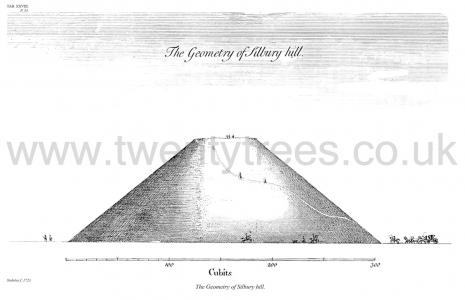
Servius on the second Æneid, writes, "anguis is a proper name of the water-snake, serpens of the land, draco of those belonging to temples." By which, ultimately, our representations must be meant, tho' probably by the author not understood, as having no acquaintance with our kind of works. But it unavoidably brings to our mind the temples of the ancients kept by dragons, which we so frequently meet with in classical history. And we may well presume they mean such temples as this of Abury, Dracontia.
"The serpent," says Maximus of Tyre, Dissert. 38. "was the great symbol of the deity to most nations, and as such was worshipped by the Indians." The temples of old made in the form of a serpent, were called for that reason, Dracontia. The universality of this regard for serpents, shews the high antiquity of the symbol, and that it was antediluvian.
To give us light into the affair, first it will be convenient to discourse a little concerning the nature of the serpent, and why mankind should make it a symbol of divinity. For it looks a little strange, after our first mother was seduced from her innocence, by the devil under this form, that so high a regard should be paid to it.
The first learning in the world confided chiefly in symbols. The wisdom of the Chaldeans, Phœnicians, Egyptians, Jews, of Zoroaster, Sanchoniathon, Pherecydes Syrus, Pythagoras, Socrates, Plato, of all the ancients, that is come to our hand, is symbolic. "It was the mode," says Serranus, on Plato's Symposium, "of the ancient philosophers, to represent truth by certain symbols and hidden images. It leads us gradually, sweetly, yet most efficaciously, towards the contemplation of the first being, which is the end of all philosophy and theology." We may add, it was the method of ancient divines too, from the beginning to our Saviour's time. No one cultivated it more than he, in all his sermons and discourses, which were affecting, well wrought up, lively, apposite, entertaining in the highest degree. Some of them complete dramas. And in general, we must conclude, it gives a beautiful gloss and amiable face to truth.
That the Druids studied in this enigmatic and symbolic way, appears from what we are writing upon; and Diogenes Laertius, in his proem, affirms it of them. He ranks them with the Magi, Chaldeans, and Gymnosophists, gives some of their doctrines, and makes them rather ancienter than the Egyptians, meaning the learned among the Egyptians. He says, "the Gymnosophists are descended of the Magi, and some affirm the Jews too." He means the ancestors of the Jews, Abraham in particular. I believe, Druids, Chaldeans, Gymnosophists, and Egyptians, all descended, or rather disciples of the Magi, who were the first and patriarchal priests after the flood. Sanchoniathon calls Shem (as I take it) by the name of Magus, as the prince of the order. He says the Egyptians vail their doctrines under the figure of beetles, snakes, birds, and other animals. And it seems to be the origin of animal worship in Egypt. Thus Gale, in his court of the gentiles, P. I. p. 64. again P. II. p. 35. "the ancient mode of expressing things worthy of memory, by hieroglyphic forms, notes, and symbols, was very common amongst the ancients, in the oriental parts especially, both poets and philosophers; and exceeding proper for that infant state of the world, wherein knowledge was so imperfect and impolite. And we need no way doubt but that this symbolic kind of discourse, or language, had its original from the divine œconomy which God prescribed in his infant church, 56consisting of many terrene images and sensible forms, symbols and types, for the shadowing forth highest contemplations and heavenly mysteries. Which way of conveying and preserving knowledge is not only helpful to the memory, grateful to the fancy and judgment, but also very efficacious for the moving of the affections."
A symbol is an arbitrary, sensible sign of an intellectual idea. And I believe the art of writing at first was no other, than that of making symbols, pictures, or marks of things they wanted to express. So that every letter was the picture of an idea. This was the first and antediluvian way of writing, before alphabet writing was invented. This latter was a postdiluvian invention, in my opinion. The reasons I shall give on another more immediate occasion. Servius, on the Æneid V. septem ingens gyros, speaking of the snake encompassing Anchises's tomb, writes, that this method was prior to alphabet-writing. I believe the Chinese method of writing to be the antediluvian one; and the like, perhaps, may be affirmed of the Egyptian hieroglyphics. The Egyptians had the good sense, when alphabet writing was communicated to them, to embrace it, tho' the Chinese will not. Still the Egyptians retained a particular veneration for their former method, and dedicated it to sacred uses altogether.
This symbol of the snake and circle, which is the picture of the temple of Abury, we see on innumerable Egyptian monuments. Always it holds the uppermost, the first and chief place; which shews its high dignity.
Mr. Selden, upon the Arundel marbles, p. 132, says, "this figure in abbreviated writing, among the Greeks, signifies Δαιμων, the deity." [Symbol inline in the text shown below] And Kircher, in his third tome, affirms the like of the Brachmans of the East-Indies.
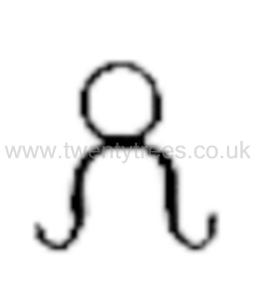
I can by no means admit it to be an Egyptian invention. The Egyptians took this, and hieroglyphic writing in general, from the common ancestors of mankind. This is sufficiently proved from the universality of the thing, reaching from China in the east, to Britain in the west, nay, and into America too.
Nothing of so high account among the Chinese, as the representation of dragons and serpents, as we see in all their pictures and utensils; nay, the very stamps upon their ink. 'Tis the genial banner of their empire. It means every thing that is sacred among them. In baron Vischer's elegant book of ancient architecture, Tab. XV. you have the picture of a Chinese triumphal arch (of which there are many in the city of Pekin) twice upon it is pictured, in a tablet over the front, a circle and two snakes, as on Egyptian works. They adorn their temples, houses, habits, and every thing with this figure, as a common prophylaxis. I apprehend it was from the beginning a sacred amuletic character. 'Tis carved several times on the cornishes of the temple (I take it so to be) of Persepolis, as we see in Sir John Chardin, Le Brun, Kæmfer. Dragons were the Parthian ensigns, from whom the Romans in later times took them, and our saxon ancestors from the Romans. 'Tis a known verse in the satyrist,
Pinge duos angues, sacer est locus. [Paint two snakes, it is a sacred place.]
The Druids had no less a veneration for it, as we find by Abury and by their fondness of snake stone beads and the like, which Pliny calls snakes' eggs, and discourses on, largely, in relation to our Druids.
Table XXIX. Top: A Group of Barrows on the side of the valley above Beckampton [Map]. Bottom: A Group of Barrows upon Overton hill [Map].
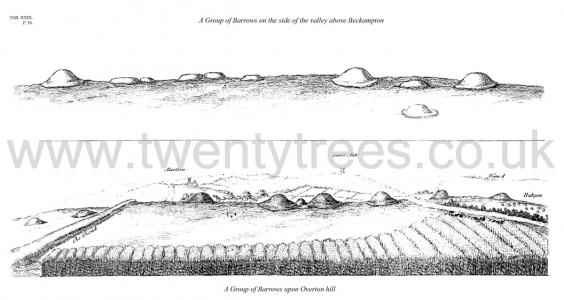
Here we see the sacred regard paid to snakes from China to Britain. Still as we before suggested, it appears somewhat strange, when we consider that the patriarchs, of whose age and times we are now chiefly treating, were not ignorant of the evil derived to mankind thro' this creature.
We may satisfy our selves about this difficulty, by considering, 1. the natural history of the serpent, and 2. the nature of forming of symbols.
First, the natural history of this animal. Can we divest our selves of original prejudice, we must allow the serpent kind, as to their outward appearance, among the most beautiful creatures in the world. The poets, those great masters of nature, are luxuriant in their descriptions of them, comparing them to the most glorious appearance in the universe, the rainbow. Thus Virgil Æneid V.
Cæruleæ cui terga notæ, maculosus & auro [Blue with back markings, speckled and gold]
Squamam incendebat fulgor; ceu nubibus arcus [The scale was burning with lightning; or a rainbow in the clouds]
Mille trahit varios, adverso sole colores. [It draws a thousand different colors against the sun]
Thus Lucan,
Serpitis aurato nitidi fulgore dracones. [The dragons glittered with golden serpents.]
——cristis præsignis & auro. [with crests and gold]
Igne micant oculi—— [His eyes flashed with fire] Ovid. Met. 3.
Of Cadmus's snake.
Hephæstion II. writes concerning the Hydra of Hercules, that half his head was of gold. I saw a snake of such exquisite beauty in Surrey. The motion and the appearance or bright golden colour, being so like to angelick, seraphick beings; no wonder the ancients conceived so high a regard for the serpent, as to reckon it a most divine animal. There is a kind of them bred in Arabia and Africa, of a shining yellow colour, like brass, or burnished gold, which in motion reflects the sun-beams with inconceivable lustre. Some of them are said to have wings, called Seraphs, Saraphs, Seraphim, mentioned Deut. xii. 15. this is the name given to the brazen serpent. And equally to the angels and celestial messengers, who are described of this appearance, in scripture. So the cherubim that supported the Shechinah in Ezekiel i. 7. "sparkled like the colour of burnished brass." The divine appearance between the candlesticks in Apocalypse i. 15. "His feet were like to fine brass, as if they burned in a furnace." Hence his ministers are called a flame of fire. Psalm civ. 4.
Secondly, consider the motion of a serpent,'tis wonderful; performed without the help of legs, nay incomparably quicker than their kindred of the crocodile and lizard kind, which have four legs: 'tis swift, smooth, wavy, and beautiful. The ancients conceived it to be like the walking of the gods; whence the notion of deifyed heroes, with serpents' feet. Pherecydes Syrus says, the gods have snakes' feet: meaning their motion was smooth and sweeping, without the alternate use of legs.
Heliodorus III. speaks of the wavy motion of the gods, not by opening their feet, but with a certain aerial force; it was called incessus. Non ambulamus, sed incedimus, says Seneca.
Ast ego, quæ divûm incedo regina, Jovisque [But I, the queen, who I have divided, will go, and Jove]
Et soror & conjunx——[And sister and spouse] Virg. Æn. 1.
Et vera incessu patuit dea. [And the goddess appeared in her true course.]
So the prophet Ezekiel describes the motion of the alate globes under the cherubims' feet; as it ought to be understood, Ezek. i. 12. Sanchoniathon the Phœnician in Euseb. p. e. I. 7. writes, that the nature of serpents is divine. "Tis the most spiritual animal of all and fiery; that it performs all its various motions by its spirit, without other organs;" and much more of this kind, to our purpose. Jerem. xlvi. 22. The shout and the march of an army is compared to the motion of a serpent.
Thirdly, from the form, pass we to the mind of the serpent, if we may be allowed so to talk. The wisdom of this creature is celebrated from the time of creation itself. Moses writes, it was more subtle than any other creature, Genes. iii. 1. Our Saviour recommends to the ministry, to imitate the prudence of serpents, as well as the innocence of doves: he makes it the symbol of Christian prudence. The psalmist compares the slyness of the wicked to the serpent, which refuses to be charmed. Aristotle writes, that this animal is very crafty; but if we inquire into authors, concerning this wisdom of the creature, nothing occurs satisfactory: in truth 'tis figurative and symbolical; meaning the charm of rhetorick and oratory, taken from the divided tongue of this creature, and more especially regarding the preachers of evangelical truths: διγλωσσία among the antients was prudence. Our Saviour in the forecited place of the apocalypse, is represented with a two-edged sword in his mouth, meaning the efficacy of preaching. The people affirmed, "never man spake like this man;" and he sent the divine spirit of eloquence and languages upon his apostles, in the likeness of cloven tongues of fire.
Servius on the second Æneid, speaking of the tongue of Laocoon's serpent,
Sibila lambebant linguis vibrantibus ora, [The whistles licked their lips with vibrating tongues,]
tells us, no creature moves its tongue with so much swiftness; so that it seems triple.
——tresque vibrant linguæ—— [and the tongue vibrates]
Says Ovid of Cadmus's snake.
The tongue was the only active arms of the apostles, as the bifid tongue of the serpent is its only weapon; and which, as the ancients thought, carried life and death with it.
From the numerous and credible accounts I have seen, snakes, I am persuaded, have a power of charming, by looking steadfastly with their fiery eyes, on birds, mice, and such creatures as they prey upon. They are put into such an agony, as to run by degrees into their open mouth. Further, snakes were thought to have an inchanting power, not only with their eyes, but likewise by whispering into the ears: for by that whispering they communicated a prophetick and divine spirit. The scholiast of Euripides writes, of Helenus and Cassandra, that serpents licking their ears, so sharpened their hearing, that they only could hear the counsels of the gods; and became great prophets thereby. This incantation by the ears, is elegantly applyed by the fathers, in their writings, to the preachers of the gospel, and to our Saviour himself. Clemens in pædagog. V. calls him Επωδὸς the inchanter, as the learned Spanheim observes: and often St. Chrysostom uses the like expression.
Table XXX. Milbarrow [Map] in Monkton 215 f. long 55 broad set round with great Stones, the broad end Eastwd. the narrow end W. drawn 10 Iuly 1723
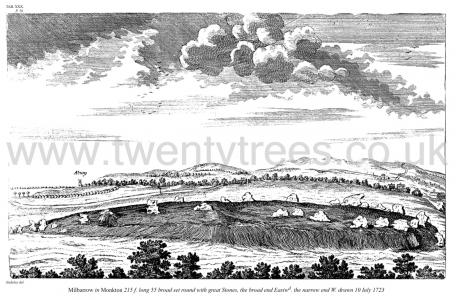
All these put together, I take to be some good reasons (to omit several more for brevity's sake) for the extraordinary veneration paid to this creature, from all antiquity. Our oldest heathen writer Sanchoniathon says, the Phœnicians called it agathodæmon, the good angel. Epies the Phœnician in Eusebius pronounces it a most divine animal. Maximus of Tyre before quoted writes, that the serpent was the great symbol of the deity, in most nations, even among the Indians. Sigismund in his Muscovite-history, says the like of the Samogitians, in the northern parts of that vast empire. Gaguin in his Sarmatia, of the Lithuanians. So Scaliger in his notes on Aristotle of animals, concerning the people of Calicut in the East-Indies; all books of travels into the West-Indies, the like. This sufficiently proves the notion nearly as old as mankind.
From these notions in antiquity, arose the strange humour of the ophite sect or heresy, who affirm the seducer serpent was the son of God. Epiphanius, Tertullian, St. Augustin and others speak of it. They kept a serpent in a box and worshipped it.
2. We are to consider the nature of forming of symbols. The serpent simply, as it was cursed of God, and composite, as hanging on a tree, was symbolical of Christ: according to the sense both of Jewish and Christian writers.
We have seen the serpent in very advantageous light, which was in order to remove our prejudice, by the high notion its natural history presents us, to which much might have been added. But this is not necessary in the formation of symbols, for if we should think this a mean and contemptible animal, unworthy to convey to us so great an idea, I answer, it was one of the arts of the inventors of symbols and emblems, to picture out the highest things by what we may esteem the lowest subjects: a beetle, for instance, is the symbol of no less than what the heathen call anima mundi; and to picture out the greatest good by its contrary. Just as Isaiah in the prophetical style calls that most excellent prince king Hezekiah, by the name of dragon, basilisk, cockatrice, and fiery flying serpent, xiv. 26. This is understood not in regard to any pravity of his own disposition, but in regard to the enemies of God's people, to whom he was as a dragon, a divine avenger against enemies, a protector of his own. Again consider the serpent as a prophylactick symbol, and the highest of sacred characters, thought most effectually to guard against and drive off all evil power. It was the method in making these prophylactick symbols, to take the figure of the thing we want to remedy. A most remarkable and apposite instance of this nature, is the famous brazen serpent erected by Moses, being suspended on a cross-pole, like that on which military banners are hung. They that were bitten by the fiery serpents, were ordered to look on this, and be whole. So that manifestly the symbol is to excite faith and obedience. They are the proper cure, not the intrinsick efficacy of the symbolical figure, Wisd. xvi. 6, 7.
All writers Jewish and Christian with one mouth assert, this was a type of the Messiah. Philo is in a rapture about it; supposes somewhat extraordinary, future, is meant thereby. Rabbi Moses Gerundinensis writes thus. "It seems to me, concerning this mystery, that 'tis agreeable to the course of the divine law, as to miraculous works, that the mischief should be remedied by a thing similar to that which caused it." And it makes the miracle more illustrious and divine, that God should direct a snake to cure those bitten by snakes.
Others of the rabbin are of the same way of thinking, as David Kimchi, Michlol II. And Abarbenel upon the place, f. 305. And Nachmanides. Our Saviour applies the Mosaic serpent directly to himself; no wonder then that the Christian fathers do so. Christus veluti serpens in cruce pependit, says St. Ambrose. Moebius treats largely of this resemblance between Christ and the serpent, exercitatio de æneo serpente, p. 63. Highly honoured was the serpent, that, as it had been the instrument of introducing the greatest evil to mankind, to it was directed God's word when he promised to us the greatest good, the Messiah, implyed in those words, Gen. iii. 15. He shall bruise thy head: αυτος in the LXX.
Another like case is that in 1 Samuel v. the ark of God was taken captive by the Philistines, and they dared to look into the venerable secrecy thereof. The nation was smote in the hinder-parts, the organs of generation, which the scripture modestly calls emerods, hæmorrhoidals. Moreover a terrible pestilence killed many, and a plague of mice at harvest-time came upon them, and devoured all the fruit of their ground. In order to make an atonement, they sent away the ark again, with golden figures of the emerods and mice, a present accompanying of costly jewels, as a consecrated λουτρον, or satisfaction to the God of the Jews. Here, by the way, we should be blind if we did not see the origin of the phallus among the heathen.
Therefore to apply this. In regard to the seeming difficulty we at first took notice of, paying such a regard to an animal which the ancestors of mankind had so much reason to detest. Did the devil injure us under the form of a serpent? The like figure is the properest of any to symbolize the remedy, the antidote against the poison whereby the devil wrought man's fall. Therefore, naturally, the same is to symbolize the Messiah then promised, who is to work man's redemption. And St. Athanasius, Tom. II. quæst. 20. scruples not to make a comparison between the union of the serpent and the devil, in the fatal temptation; to the union of the divine and human nature in our blessed Saviour. The venomous serpent is his human nature, sinful, infected by the devil's treachery; he was made sin for us, tho' not contaminated himself. Tho' not venomous, he cures the venom of our nature. I observe that the rabbies, tho' they saw sufficiently, how necessarily the Mosaic serpent was applicable to the Messiah, yet they were somewhat fearful therein, and of speaking their mind upon it, for fear of doing ill, in comparing him to an accursed animal. But our Saviour himself was not fearful in comparing himself to it, and the rather on that account, took it for a very express type of his crucifixion, and of his being accursed for our sakes, Deut. xxi. 25. John iii. 14. Galat. iii. 13, i. e. devoted as a sacrifice, an expiation, that we being freed from the curse of sin, might obtain the blessing of God. So our Christian writers explain the type between our Saviour and the brazen serpent in the wilderness. Bede in particular, on John iii. And here we see the nature of types, where a man that undergoes the curse and punishment of the law, becomes in reality a type of the Messiah. A serpent which pictures out the evil principle, the like, 2 Cor. v. 21. Assuredly Moses, by the holy Spirit, meant it to regard 61Christ's crucifixion. A fit emblem of his divinity, thro' that remarkable quality of their throwing off old age with their skin, and returning to youth again. For so the ancients thought:
Anguibus exuitur tenui cum pelle vetustas. [Snakes are stripped of their thin old skin] Tibullus.
A fit emblem of his resurrection from the dead, and of returning to an immortal life.
Table XXXI. The Long Barrow S. of Silbury Hill [West Kennet Long Barrow [Map]]. An Archdruids barrow.
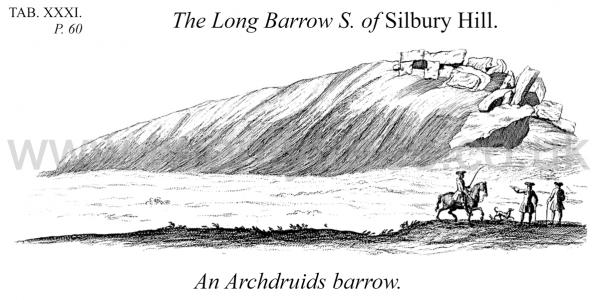
No wonder then, from such reasons as these, and others as obvious, the ancients concluded this to be the most divine of all animals, and thought it the aptest symbol of the Νους ἑτερος, the other, or second mind of Plato, whom they affirmed to be the creator of the world. I know not whether this notion of theirs did not farther contribute to it; they thought these animals brought forth by the mouth. They have too no limbs, or members for action, but exert their mighty power by the mouth only; whence Horus Apollo says, "a serpent is the symbol of the mouth." This well represents the omnific WORD, which Suidas speaks of from Trismegistus, all perfect, fruitful, the workman, creator of the world.